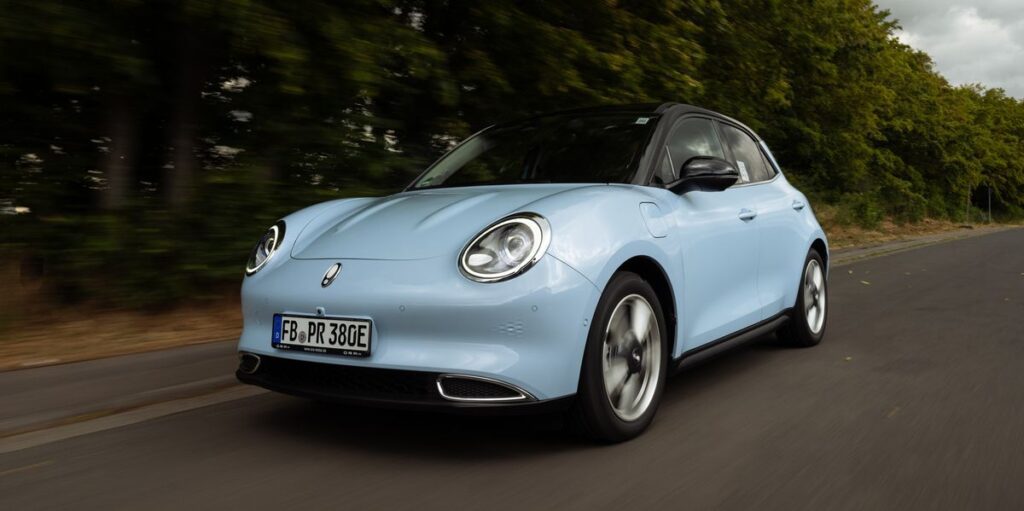Great Wall Motor Company's Ora Funky Cat Is True to Its Name

It is always brave to call the final result of any contest before it has ended. Yet it seems impossible that anything will beat Great Wall Motor Company’s Ora Funky Cat for the title of the most oddly named vehicle C/D will drive this year.
This is no self-built special. The Funky Cat is an electric hatchback from China’s GWM, an automotive group that produced no fewer than 1.2 million vehicles last year and is in a joint venture with BMW to produce the next Mini EV hatchback. GWM subsidiaries include Havel, Wey, and the intriguingly named Tank—which, appropriately, makes nothing but boxy SUVs. Ora is an electric-only brand that gives its models feline names and is aimed at younger buyers. In the People’s Republic, our subject is the Haomao, or “Good Cat,” but when exported to Europe this cat gets to be Funky.
The Funky Cat sits on what GWM calls its L.E.M.O.N. platform, an apparent (and unfortunate) acronym that isn’t explained in any greater detail on its corporate website. But don’t let the twee name and cutesy looks fool you. Beneath all that lies a generally well-engineered car, one that can compete with better-known rivals on range, performance, and—perhaps most important—price.
Every Ora model gets retro styling, and compared to some of its siblings the Funky Cat’s slightly startled front end can be regarded as getting off lightly. It is no surprise to discover that credited designer Emanuel Derta formerly worked for Porsche; the chrome-ringed round headlights are reminiscent of the units found on early-1970s 911 Carreras. The Funky Cat’s design is positively restrained when compared to other Ora models—the Lightning Cat sedan looks like a proto-Panamera, and the Ballet Cat is a four-door take on the original Volkswagen Beetle.
Seen from the side or rear the Funky Cat looks more modern, although its combination of curves and short overhangs makes it look smaller than it is; at 166.7 inches in length, this feline is only slightly larger than the last-generation Hyundai Kona EV. Inside, the five-seat cabin has decent space for occupants both front and rear, the design is unfussy, and materials seem upmarket enough. The old-school theme extends to chrome-effect switchgear and pleated trim that wouldn’t feel out of place in a 1960s sports car. This is pleather rather than leather, but it still feels convincing once that secret is known. Disappointingly, the metal switches feel insubstantial when operated, as does the rotary R/N/D direction selector, but your fingers need to explore the lower reaches of the dashboard and seat bases to find any cheap-feeling plastics.
The Ora has two 10.3-inch landscape-oriented displays—one a digital instrument cluster, the other a touch-sensitive control screen—but the interface isn’t the snappiest to operate.
All European-market Funky Cats feature a single 169-hp motor turning the front wheels that draws energy from a lithium-iron-phosphate battery with an estimated 43.0 kilowatt-hours of usable capacity (a larger pack with an estimated 57.0 kilowatt-hours is optional, but we have yet to drive that setup). Under Europe’s optimistic WLTP protocol, the standard pack has an estimated range of 193 miles, or approximately 164 miles in EPA methodology. One weakness is fast-charging, as the Funky Cat only supports DC fast-charge rates up to 80 kilowatts, well below punchier rivals. On the plus side, it is lighter than most similarly sized alternatives, with the smaller-pack car weighing 3395 pounds by Ora’s measurements.
Performance feels strong for a junior EV. Off the line, the Funky Cat can be made to chirp its front tires on dry asphalt, the traction control taking a laid-back approach to intervention. Acceleration stays brisk until around 60 mph, tailing off rapidly above that. Ora quotes 8.3 seconds to reach 62 mph, but it feels subjectively quicker. Past 70 mph, the car seems to hit a half-life curve, with each successive 10-mph increment taking twice as long as the last to arrive; confirming the 99-mph limiter would require both patience and a longer straight than we could find on our German test route. (No, we didn’t go onto the autobahn.)
Refinement is good at gentle speeds, with a soft suspension pillowing urban bumps. But wind and tire noise build quickly with velocity, and when traveling faster over rough roads there was the occasional sense of floatiness, the Funky Cat feeling under-damped. Grip levels proved reasonable, but there was no joy to be found in trying to push the limits of adhesion amid early-onset understeer and a lack of feedback. The inconsistent regenerative braking also added to the sense of dynamic disconnect, taking awhile to build resistance after the accelerator was lifted.
But the biggest distraction from the cabin’s calm was a multitude of beeps and alarms. The Funky Cat has a speed-monitoring system that pings every time the car goes above a posted speed limit, even by a single mph. The lane-keep assistant chimes if it feels the car is straying from its lane, eventually intervening further with aggressive self-steering. A driver-monitoring system adds yet further admonishment if it thinks the pilot’s attention is wandering. Deactivating these is an awkward, multi-stage process, and the lane-keep system frustratingly defaults to on with each restart.
The standard fitment of these systems—as well as active cruise control and blind-spot monitoring—seems to be one of the primary reasons the Funky Cat achieved a class-leading score in the Euro NCAP safety ratings. But in our experience, Ora added what felt like an unsafe level of distraction.
GWM Ora
For European buyers the Funky Cat’s most attractive detail is its price, with the standard version asking the equivalent of $35,700 in Germany before tax. That’s aggressive, but Volkswagen recently announced it is cutting the starting price of the face-lifted European-market ID.3 Pro—with 201 horses and a 58.0-kWh battery—to about $36K before tax. Yet Great Wall has plenty of room to respond with more aggressive cuts if it wants to. In China, the most basic version of the Good Cat, with the smaller battery and a 141-hp electric motor, costs just RMB 107,800 ($14,850).
The Ora Funky Cat feels like it’s 90 percent of a car. The basics are all good, but the details still require more polish.
Arrow pointing downArrow pointing down
Specifications
Specifications
2023 GWM Ora Funky Cat
Vehicle Type: front-motor, front-wheel-drive, 5-passenger, 4-door hatchback
PRICE (Germany)
Base: $35,700
POWERTRAIN
Motor: permanent-magnet synchronous AC, 169 hp, 184 lb-ft
Battery Pack: liquid-cooled lithium-iron-phosphate, (C/D est) 43.0 kWh
Onboard Charger: 6.6 kW
Peak DC Fast-Charge Rate: 80 kW
Transmission: direct-drive
DIMENSIONS
Wheelbase: 104.3 in
Length: 166.7 in
Width: 71.9 in
Height: 63.1 in
Cargo Volume, Behind F/R: 30/8 ft3
Curb Weight (C/D est): 3400 lb
PERFORMANCE (C/D EST)
60 mph: 7.5 sec
1/4-Mile: 16.5 sec
Top Speed: 99 mph
EPA FUEL ECONOMY (C/D EST)
Range: 164 mi

Senior European Correspondent
Our man on the other side of the pond, Mike Duff lives in Britain but reports from across Europe, sometimes beyond. He has previously held staff roles on UK titles including CAR, Autocar and evo, but his own automotive tastes tend towards the Germanic, owning both a troublesome 987-generation Porsche Cayman S and a Mercedes 190E 2.5-16.



